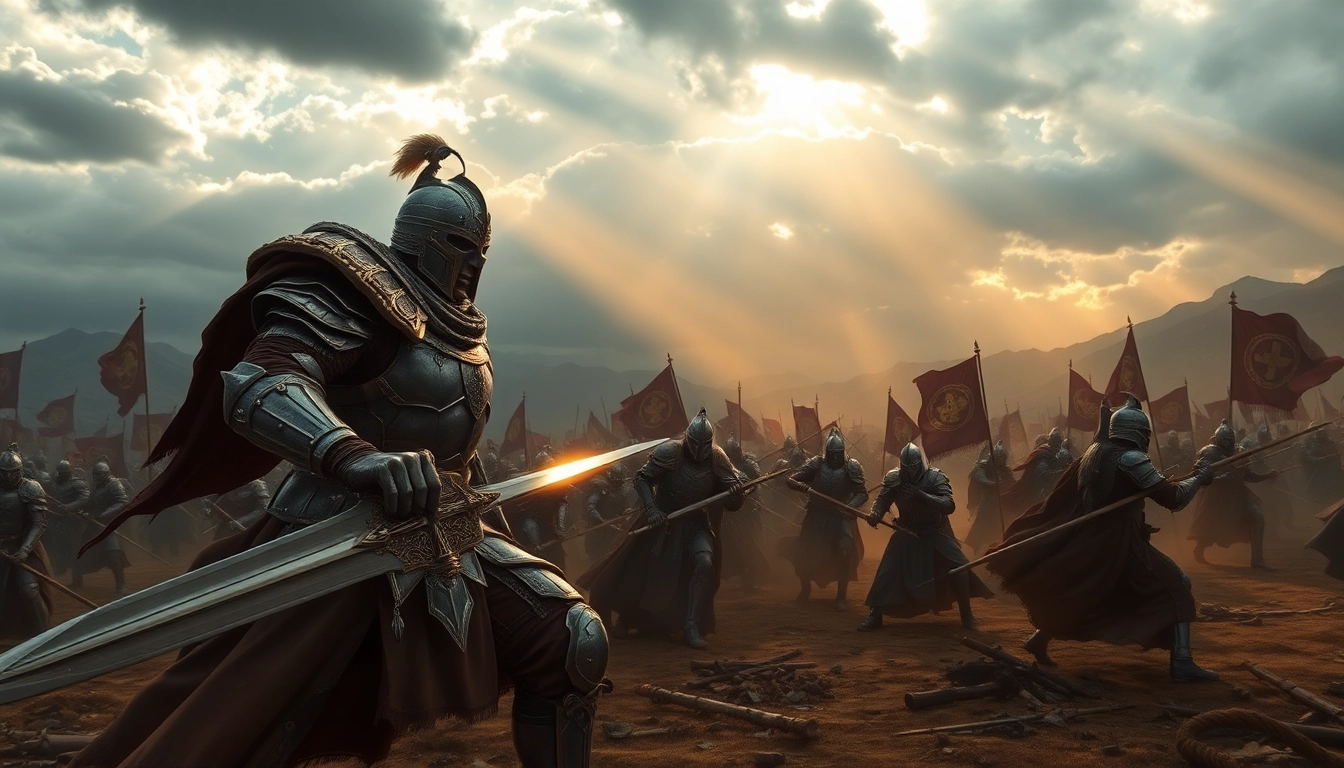
The Rise of Warlords in Strategy Games
In the realm of strategy games, the concept of warlords has captured the imagination of gamers worldwide. From their primitive origins to their sophisticated portrayals in modern titles, warlords serve as powerful figures that drive narratives, strategies, and gameplay mechanics. As we delve into the history, gameplay dynamics, and future of warlords in the gaming industry, we’ll uncover the elements that make these characters not just central to strategy games but quintessential icons of conflict and leadership in digital narratives.
History and Evolution of Warlords
The concept of warlords transcends the gaming world, with roots deeply embedded in historical conflicts where leaders would govern territories and lead armies. Early war gaming introduced players to this archetype, but it was not until the late 20th century that warlords became prominent in video game narratives. Games like “Warlords” (1989) set the foundation for what would evolve into diverse gameplay mechanics that players cherish today.
As technology progressed, so did the complexity of warlords in games. The 1990s saw the emergence of real-time strategy (RTS) games like “Warcraft” and “Command & Conquer”, which portrayed warlords as pivotal characters who could lead troops, build empires, and execute strategies on expansive maps. The resultant gameplay dynamics along with the character development presented an engaging experience that was both tactical and immersive.
Over the years, warlords have transformed into more nuanced characters, often encapsulating deep storylines and character arcs, as seen in “Total War” series and “Warhammer.” These developments reflect not just advancements in programming but also a growing desire for players to connect emotionally with the characters they are controlling.
Core Mechanics of Warlord Gameplay
The mechanics of gameplay involving warlords revolve around resource management, strategic planning, and tactical execution. Players must gather resources, develop their units, and command their warlords in a way that capitalizes on strengths while mitigating weaknesses. At the heart of this gameplay is the warlord’s ability to lead, which often translates into unique abilities, unit buffs, and influence over territories.
Different titles utilize warlords in various ways—some may allow for customizable abilities, while others focus on historical accuracy, where players engage with actual warlords from history, complete with their known attributes and leadership styles. This dynamic adds a layer of personalization and strategy rarely found in other genres.
The strategic depth is further enhanced with elements such as terrain features, troop formations, and enemy AI that react intelligently to player decisions, urging players to think critically about every move they make. This evolving gameplay landscape ensures that players remain engaged, always seeking out ways to advance their warlord and their tactical position.
Analyzing Top Warlord Titles
Warlords have been featured in countless games, but some have distinctly shaped the genre. Titles such as “Warlords Battlecry”, “Total War: Warhammer,” and “Age of Wonders” exemplify the evolution of this archetype. Each of these games incorporates unique aspects that enhance the role of warlords within their respective contexts.
“Warlords Battlecry” revolutionized the genre by combining real-time strategy with RPG elements, allowing players to develop their hero warlords through experience points and skill trees. This diversification meant players had to engage in thoughtful resource management while ensuring their warlord was powerful enough to lead their armies effectively.
In “Total War: Warhammer,” the immersion is heightened with a complex narrative intertwined with solid gameplay mechanics. Players navigate through vast maps while engaging in tactical battles. The warlords, in the form of legendary generals, provide buffs to units and create diverse strategies that engage players in both army composition and battlefield tactics.
These titles not only showcase the multifaceted nature of warlords but also how they adapt to the changing landscape of gaming technology, narrative storytelling, and player engagement techniques throughout the years.
Understanding Gameplay Dynamics of Warlords
Warlord gameplay dynamics create a rich tapestry of interactions that players navigate. Understanding these dynamics can significantly improve one’s performance and strategic engagement within games that feature these powerful characters.
Resource Management Strategies
Effective resource management is a defining characteristic of successful gameplay with warlords. Players must create an equilibrium between gathering resources, upgrading units, and maintaining troop morale. Commonly, games introduce various resources such as gold, food, and manufactured goods that players must collect to sustain their armies.
The key to successful resource management hinges on understanding the gameplay’s economy and predicting the player’s needs based on the map. For instance, controlling territories that generate high resources is crucial, but so is ensuring that these territories are defensible against enemy incursions.
Advanced players often engage in “resource trading” with allies, ensuring that all players gain the resources they need while maximizing collective strength against enemies. As a warlord, one must continuously weigh when to expand for resources and when to solidify current holdings, balancing ambition with caution.
Combat Tactics and Enhancements
The battlefield is where a warlord’s skills and strategy truly shine. Understanding combat tactics can be the difference between victory and defeat. Effective players often focus on unit composition, ensuring a mix of offensive and defensive capabilities. The synergy between different unit types, such as infantry, cavalry, and archers, creates a comprehensive strategy that can adapt to various combat scenarios.
Enhancements through upgrades or special abilities add another layer to combat dynamics. Warlords typically have unique abilities that can turn the tide of battle—be it through area-of-effect spells, troop buffs, or leadership skills that enhance unit performance. Timing the use of these abilities can create game-changing moments in battle.
Furthermore, the knowledge of terrain and positioning can provide significant tactical advantages. Players must utilize high-ground advantages and employ flanking maneuvers to exploit enemy weaknesses. This depth of strategy is what makes warlord-class games engaging and endlessly replayable for tactical enthusiasts.
Player Engagement Techniques
Player engagement in games featuring warlords revolves around creating a sense of purpose and achievement. Game developers employ various techniques to keep players immersed. Mechanics such as leveling systems, character customization, and narrative arcs enhance the player’s investment in their warlord.
Achievements and rewards systems not only provide incentives for players to explore different gameplay strategies but also offer a sense of progression that fuels ongoing engagement. Online leaderboards and community challenges further foster a competitive spirit among players who wish to prove their superiority as warlords in a digital space.
Developer engagement with the community through feedback, game updates, and expansions also plays a crucial role in maintaining interest. By actively responding to player needs and suggestions, game companies build a loyal following, ensuring that titles remain relevant and enjoyable.
The Role of Warlords in Multiplayer Modes
The multiplayer aspect of strategy games featuring warlords presents unique challenges and opportunities for collaboration and competition. Player interactions can lead to dynamic game experiences that are both cooperative and adversarial.
Building Alliances and Collaborations
In multiplayer modes, alliances become indispensable. Players often form coalitions to counter larger threats or coordinate strategies for mutual benefit. Effective communication tools within the game enable players to strategize effectively, creating a social dynamic that enhances the gameplay experience.
These alliances can take various forms, from temporary truces to formal alliances with set agreements on resource sharing and military support. Strategic deception is also an integral gameplay aspect, as players might feign alliances while plotting against their temporary allies, reflecting real-world diplomatic strategies in a fantasy setting.
Furthermore, the role of a warlord can vary between cooperation and competition—sometimes, players must prioritize their advancement at the cost of allied players, creating intense gameplay dynamics that keep combat unpredictable and engaging.
Competitive Strategies for Warlord Battles
Competition in multiplayer settings is often framed around skill and strategy. Players must not only showcase their knowledge of the game mechanics but also remain agile in their strategies. Successful competitive warlords often study opponent habits and preferences, looking for patterns that can be exploited.
The application of psychological tactics can also play a significant role. For instance, creating false aggression through strategic retreats or feigned offensives can lead opponents to make errors, giving the cunning warlord an upper hand. The use of technology, such as bots that predict enemy movements or behavior, further enhances the competitive landscape。
Additionally, the analysis of past matches provides valuable insights that players can leverage for future encounters. Understanding common strategies and adapting to counter them is vital for maintaining competitiveness in the ever-evolving realm of warlord gaming.
Player Behavior Insights and Trends
Monitoring player behavior can yield valuable insights into engagement and retention strategies. Players consistently demonstrate a preference for deep mechanics that allow for diverse gameplay styles, indicating a demand for strategic flexibility in warlord roles.
Data collected from game sessions reveals trends such as preferred factions, popular unit builds, and common strategy combinations. This data can help developers enhance game balancing and provide players with the tools to engage more deeply with the content.
Another trend includes the increasing desire for narrative depth, especially among younger players who seek immersive storytelling alongside gameplay. Considering these insights, developers can create content that appeals to both strategic enthusiasts and narrative seekers, enriching the gaming experience.
Incorporating Warlords into Game Design
The design and development of warlords in games is a multifaceted process that shapes not only character interaction but also overall game balance and player experience.
Character Development and Storylines
Character development is the lifeblood of engaging gameplay. Warlords with well-crafted backstories, motivations, and arcs encourage players to become invested in their journey. Storylines that reward exploration and achievement through character progression create a stronger emotional connection.
Moreover, as warlords evolve, so too can their mechanics and abilities, reflecting their personal growth and experiences. Players appreciate the narrative elasticity that connects gameplay and character development, which encourages repeated play through different story paths and character builds.
Incorporating different narrative paths, character dialogues, and moral choices further deepens player engagement, making choices impactful and altering gameplay outcomes significantly. Developers can leverage branching narratives to create unique experiences that cater to various player preferences.
Balancing Warlord Powers for Fair Play
Balancing warlord powers is critical to ensure fair play in games. Overpowered characters can lead to frustration among players and diminish enjoyment. Continuous adjustments based on player feedback can help maintain game integrity and competitive fairness.
Implementing a feedback loop, where player performance metrics are analyzed post-match, enables developers to evaluate the effectiveness of warlord abilities in real-time. This approach allows developers to stay ahead of imbalances and adjust characters accordingly in future patches.
Moreover, transparent communication about these changes fosters goodwill in the community, as players are more likely to appreciate adjustments that aim to enhance their gaming experience rather than viewing them as punitive measures.
Integrating Feedback into Game Updates
Feedback from players provides invaluable insights that can shape future updates and enhancements. Developers who actively engage with their community can better craft content that reflects player desires and expectations. This includes adjustments to gameplay mechanics, the introduction of new warlords, and even expansions of lore.
Moderators and community managers can cultivate environments where constructive feedback is welcomed, allowing players to express their experiences while fostering a sense of belonging. Regular Q&A sessions, forums, and surveys are effective means of collecting player input. Utilizing this feedback to fuel continuous improvement fosters loyalty and ensures sustained interest in the game.
Future Trends for Warlord Games
The future of warlord games is ripe with potential as developers explore new technological frontiers and community-driven design. The landscape of strategy games featuring warlords is constantly evolving, hinting at exciting developments on the horizon.
Technological Innovations in Game Design
As technology advances, the integration of features such as virtual reality (VR) and augmented reality (AR) could reshape how warlords are experienced in gameplay. Imagine commanding armies in an immersive environment where players physically move to engage with the game, further enhancing their connection to the characters and the battlefield.
Additionally, advancements in artificial intelligence (AI) can lead to the creation of smarter enemies and allies, pushing the boundaries of strategy. Players would need to adapt in real-time to more dynamically evolving scenarios, fostering deeper strategic thinking and tactical engagement.
Lastly, the introduction of machine learning algorithms could provide significant insights into player behaviors and preferences, guiding developers in creating even more personalized gaming experiences tailored to distinct player archetypes.
Community Engagement and Participation
Community engagement will continue to play a vital role in the development and success of warlord games. Gamers increasingly desire a voice in how games evolve, leading to the rise of community-driven initiatives and participatory development models.
Working closely with community influencers and content creators can help build a strong foundation of support for new titles. Furthermore, crowd-funded projects that allow backer input can pave the way for innovative warlord games that directly respond to the desires of their audience.
Additionally, creating seasonal events and challenges that encourage community participation fosters engagement and long-term loyalty. Gamers feel more compelled to play and contribute when they see their input reflected in the game’s evolution.
Emerging Genres and Expanding Horizons
The blend of genres is becoming increasingly popular, and warlords can serve as catalysts for unique cross-genre experiences. Whether integrating role-playing elements into strategy or creating hybrid game modes that allow for narrative-driven gameplay, the possibilities are immense.
Collaborative gameplay modes that emphasize teamwork among warlords can further enhance the gaming experience, encouraging players to rely on each other’s strengths. This sense of camaraderie and shared triumphs can lead to a more fulfilling game environment.
In conclusion, as the gaming world continues to evolve, so too will the concept of warlords and their place within it. The richness of character development, the complexity of gameplay mechanics, and the growing emphasis on community will shape the future of warlord games, ensuring that these formidable characters continue to captivate players for years to come.







